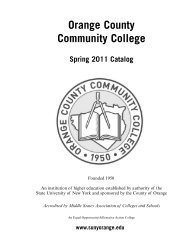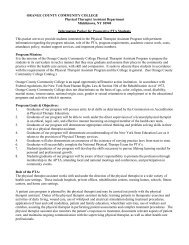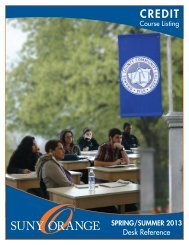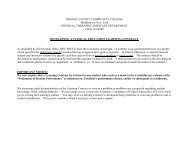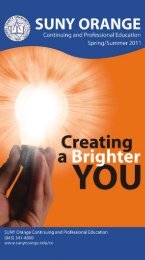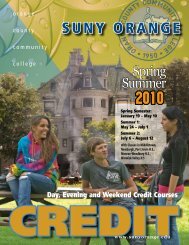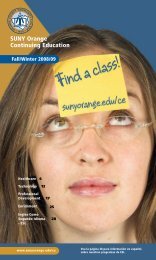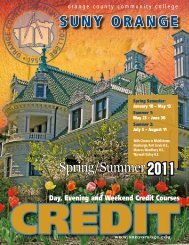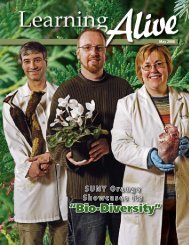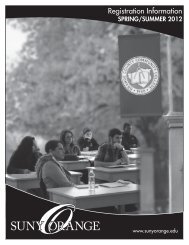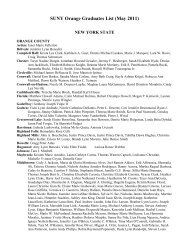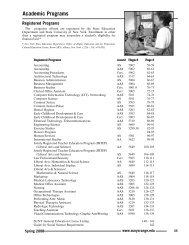You also want an ePaper? Increase the reach of your titles
YUMPU automatically turns print PDFs into web optimized ePapers that Google loves.
Occupational Therapy Assistant<br />
Occupational Therapy<br />
Assistant<br />
(Occupational Therapy Assistant Department)<br />
NOTE: Students must comply with all policies,<br />
procedures, and regulations of the internship/ fieldwork site.<br />
Failure to do so will result in immediate removal from the<br />
internship site and automatic failure of the course.<br />
NOTE: A grade of C or higher is required in all OTA—<br />
series courses to graduate with an A.A.S. Occupational<br />
Therapy Assistant degree.<br />
Failure to pass BIO 111 and/or BIO 112 may prevent<br />
progression in the Occupational Therapy Assistant course<br />
sequence. Students who fail or withdraw from either of these<br />
courses must receive special permission from the department<br />
chairperson to continue in the program sequence.<br />
Failure to pass the first ENG 160 course, corequisite to OTA<br />
101, will prevent progression into second year OTA courses.<br />
OTA 101—Fundamentals of Occupational Therapy 1<br />
2 lect., 3 lab., 3 cr. (Fall)<br />
An introduction to occupational therapy with<br />
regard to history, development, function, and<br />
underlying philosophy. Also, introduction to medical<br />
terminology, the allied health professions, and<br />
agencies involved in the comprehensive care of the<br />
disabled. Field observation in local clinical settings<br />
provide an opportunity to observe therapeutic media<br />
and applied techniques. [R-1]<br />
Corequisite: ENG 160<br />
OTA 102—Fundamentals of Occupational<br />
Therapy 2<br />
2 lect., 2 lab., 3 cr. (Spring)<br />
This course provides the student with practical<br />
experience in a variety of occupational therapy treatment<br />
interventions. Includes units on hand function; splinting;<br />
kinesiology; functional mobility; training and teaching of<br />
occupations; assistive technology; preparatory activity;<br />
assessment and evaluation; and biomechanical, cognitive,<br />
perceptual, and sensory. [R-1]<br />
Prerequisite: OTA 101 and BIO 111<br />
Corequisite: OTA 106 and BIO 112<br />
OTA 103—Occupational Performance 1<br />
3 lab., 1 cr. (Fall)<br />
Emphasis is on the understanding of human<br />
occupation and its role in well-being and health.<br />
Students engage in a variety of occupations and<br />
purposeful activities and analyze them for their<br />
therapeutic qualities and contexts. The impact of<br />
disability upon occupational performance is explored.<br />
Problem solving is emphasized through completion of<br />
a woodworking project. Students are also introduced<br />
to professional terminology and constructs based on<br />
the Occupational Therapy Practice Framework. [R-1]<br />
Corequisite: OTA 101<br />
OTA 104—Occupational Performance 2<br />
3 lab., 1 cr. (Spring)<br />
Emphasis is on the development of basic skills in a<br />
variety of minor crafts including: leather work,<br />
copper tooling, frame loom, weaving, mosaics,<br />
macrame, rug hooking and paper crafts. Principles of<br />
activity analysis, therapeutic application, and group<br />
and dyadic presentation techniques are covered. [R-1]<br />
Prerequisite: BIO 111 and OTA 103<br />
Corequisite: OTA 106<br />
OTA 106—Medical Conditions<br />
3 cr. (Spring)<br />
Medical, orthopedic, and neurological conditions,<br />
commonly referred for occupational therapy<br />
treatment are presented in regard to etiology,<br />
pathology, and accepted treatment procedures.<br />
Medical terminology is stressed. [R-1]<br />
Prerequisites: OTA 101 and BIO 111<br />
Corequisite: OTA 102 and OTA 104<br />
OTA 107—Principles of Occupational Therapy in<br />
Geriatrics and Gerontology<br />
2 cr. (Fall)<br />
This course gives the student an understanding of<br />
the unique developmental, social, psychological,<br />
environmental, and physical needs of older adults.<br />
Students learn about such topics as ageism, health<br />
care services/settings for older adults, normal aging<br />
processes, community agencies serving older adults,<br />
pathological conditions associated with aging, falls<br />
prevention, environmental safety and modification,<br />
occupation and older adults, health promotion,<br />
dementia care, depression, low vision, and death and<br />
dying. Students also attend a nursing home field visit<br />
and conduct an interview with an older adult resident.<br />
[R-1]<br />
Corequisite: OTA 101<br />
OTA 201—Principles of Occupational Therapy in<br />
Pediatrics & Developmental Disabilities<br />
3 cr. (Fall)<br />
The pattern of normal growth and development<br />
from birth through adulthood is reviewed during the<br />
initial weeks of the course. The student is then<br />
introduced to the various conditions that interfere<br />
with normal development, and the occupational<br />
therapy treatment techniques used with the<br />
developmentally disabled. [R-1]<br />
Prerequisites: PSY 220, BIO 111, OTA 102, OTA 106<br />
Corequisite: OTA 207 and OTA 203<br />
OTA 203—Clinical Reasoning Skills<br />
3 lab., 1 cr. (Fall)<br />
The emphasis of this course is on the application of<br />
clinical reasoning and problem solving skills to<br />
occupational therapy contexts. The students plan and<br />
role play treatment interventions related to a variety<br />
of clinical cases. Students engage in problem solving<br />
Spring 2012<br />
www.sunyorange.edu<br />
217




